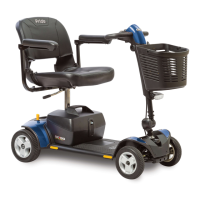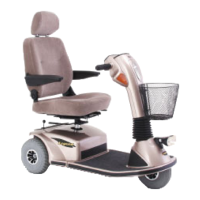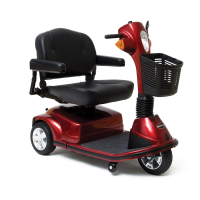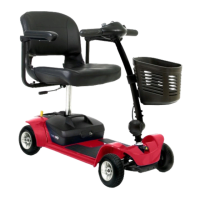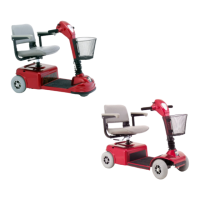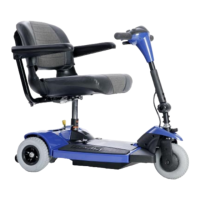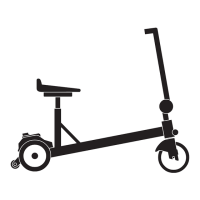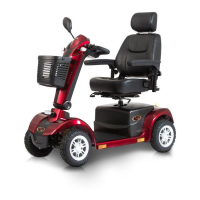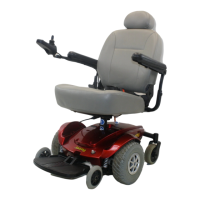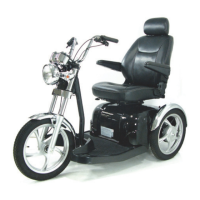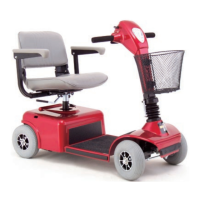
Do you have a question about the Pride Mobility scooter and is the answer not in the manual?
| Brand | Pride Mobility |
|---|---|
| Model | scooter |
| Category | Scooter |
| Language | English |
Legal agreement where the purchaser indemnifies Pride for issues arising from product misuse or lack of maintenance.
Contact information and invitation for feedback on the manual and the scooter's performance.
Invitation to register for the Owners Club for access to resources, interviews, and information.
General safety advice including understanding the manual and seeking assistance for setup or operation.
Warning against modifying the scooter's parts or functions without authorization from Pride.
Warning against lifting or moving the scooter using its removable parts to prevent injury.
Information regarding potential interference from electromagnetic fields on scooter performance.
Recommended checks before operating the scooter, including tires, connections, brakes, and battery charge.
Instructions and warnings regarding maintaining proper tire pressure (30-35 psi) for safe operation.
Information on the scooter's maximum weight capacity and warnings about exceeding it.
Safety advice for operating the scooter on inclines, including speed control and cornering.
Advice on reducing speed and steering angle when cornering to prevent tipping.
Guidance on suitable and unsuitable outdoor surfaces for scooter operation.
Warnings and instructions for safely navigating or avoiding stationary obstacles like curbs and steps.
Details on the scooter's regenerative and disc park brake systems.
Warning against operating the scooter on public streets and advice for visibility and traffic rules.
Recommendations against operating the scooter in icy, wet, or freezing conditions.
Crucial safety warnings and instructions for engaging and disengaging the freewheel mode.
Explicit warning that scooters are not designed for stairs or escalators.
Tips for safely opening and maneuvering through doorways.
Guidance on safely using elevators, including door edge safety mechanisms.
Warning against sitting on the scooter when used with lift/elevation products.
Safety information regarding battery weight, terminals, and charging a frozen battery.
Instructions for handling damaged batteries and information on recycling.
Advice on turning off power when stationary to prevent accidental movement.
Warnings and guidelines for safely transporting the scooter in a vehicle.
Safety tips and procedures for safely boarding and dismounting the scooter.
Guidance on the requirement and proper use of positioning belts for safe scooter operation.
Precautions to maintain balance and avoid tipping when reaching or bending.
Advice to consult a physician regarding medications or limitations that may affect safe operation.
Warning against operating the scooter while under the influence of alcohol.
Information on how radio waves can cause unintended scooter motion and common sources.
Answers to common questions about EMI/RFI susceptibility and prevention.
Description of the control console and its main components.
Instructions for using the key switch to power the scooter on and off.
Explanation of how to set the scooter's speed limit using the adjustment dial.
Instructions on operating the throttle lever for forward and reverse motion.
How to read the battery condition meter to check the scooter's battery level.
Information on using the horn button for signaling and safety.
Instructions for operating the scooter's headlight system.
Identification of key components located in the rear section of the scooter.
Description of the onboard 3-amp battery charger and its function.
Information on the battery charger fuse and its replacement.
Details about the scooter's batteries as the primary power source.
Explanation of the electronic controller's role in managing scooter functions.
Information on the main circuit breaker, its function, and reset procedure.
Instructions for using the manual freewheel lever to push the scooter.
Detailed steps for engaging and disengaging the freewheel mode safely.
Description of the motor and transaxle assembly for power and drive.
Importance of anti-tip wheels and warning against their removal or modification.
Guide to interpreting the battery condition meter's readings.
Step-by-step instructions for safely charging the scooter's batteries.
Answers to frequently asked questions about battery charging and maintenance.
Tips for achieving maximum range and ensuring long battery life.
Information on recommended battery types and procedures for changing a battery.
Guidance on proper disposal and recycling of scooter batteries.
Steps to properly break in new batteries for optimal performance and lifespan.
Advice on requirements for using the scooter with public transportation.
Recommendations for storing the scooter and its batteries for extended periods.
Pre-boarding checks including battery charge and freewheel lever position.
Step-by-step guide for safely boarding the scooter.
Essential checks and adjustments before starting operation.
Instructions for controlling speed, steering, and stopping the scooter.
Step-by-step guide for safely dismounting the scooter.
Explanation of the auto power down feature and how to resume operation.
Instructions on how to adjust the tiller angle for optimal comfort and control.
Guide to repositioning the seat to one of three different heights.
How to adjust the seat position forward or backward for distance adjustment.
Instructions on adjusting the width of the armrests inward or outward.
How to unlock, rotate, and lock the seat into one of eight positions.
Step-by-step instructions for safely disassembling the scooter into sections.
Detailed steps for disconnecting and separating the front and rear sections of the scooter.
Step-by-step instructions for reassembling the scooter from its sections.
Guidelines for maintaining proper tire pressure and inspecting tires for wear.
Recommendations for cleaning and conditioning exterior surfaces.
Ensuring battery terminals are tight, uncorroded, and properly positioned.
Regular checks of wiring connections and insulation for wear or damage.
Tips for maintaining the gloss of the scooter's plastic shrouds.
Information on the prelubricated and sealed nature of these components.
Note on periodic inspection of motor brushes by an authorized provider.
Instructions to keep these areas free of moisture and dry them if exposed.
Best practices for storing the scooter and its batteries for extended periods.
Details of the 3-year warranty covering structural frame and drivetrain components.
Specific exceptions to the 3-year warranty, including noise levels and brake pads.
Coverage for parts and electronic components for one year from purchase date.
List of items and conditions not covered by the scooter's warranty.
